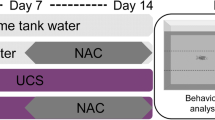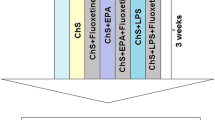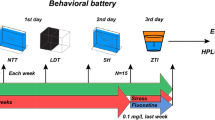Abstract
Stress is considered a risk factor for several human disorders. Despite the broad knowledge of stress responses in mammals, data on the relationship between unpredictable chronic stress (UCS) and its effects on purinergic signaling are limited. ATP hydrolysis by ectonucleotidases is an important source of adenosine, and adenosine deaminase (ADA) contributes to the control of the nucleoside concentrations. Considering that some stress models could affect signaling systems, the objective of this study was to investigate whether UCS alters ectonucleotidase and ADA pathway in zebrafish brain. Additionally, we analyzed ATP metabolism as well as ada1, ada2.1, ada2.2, adaL, and adaasi gene expression in zebrafish brain. Our results have demonstrated that UCS did not alter ectonucleotidase and soluble ADA activities. However, ecto-ADA activity was significantly decreased (26.8 %) in brain membranes of animals exposed to UCS when compared to the control group. Quantitative reverse transcription PCR (RT-PCR) analysis did not show significant changes on ADA gene expression after the UCS exposure. The brain ATP metabolism showed a marked increase in adenosine levels (ADO) in animals exposed to UCS. These data suggest an increase on extracellular adenosine levels in zebrafish brain. Since this nucleoside has neuromodulatory and anxiolytic effects, changes in adenosine levels could play a role in counteracting the stress, which could be related to a compensatory mechanism in order to restore the homeostasis.



Similar content being viewed by others
Abbreviations
- ACTH:
-
Adrenocorticotropic hormone
- ARS:
-
Acute restraint stress
- CRF:
-
Corticotropin-releasing hormone
- HPI:
-
Hypothalamic–pituitary–interrenal axis
- UCS:
-
Unpredictable chronic stress
References
Bhatia N, Jaggi AS, Singh N, Anand P, Dhawan R (2011) Adaptogenic potential of curcumin in experimental chronic stress and chronic unpredictable stress-induced memory deficits and alterations in functional homeostasis. J Nat Med 65(3–4):532–543
McEwen BS, Gianaros PJ (2010) Central role of the brain in stress and adaptation: links to socioeconomic status, health, and disease. Ann N Y Acad Sci 1186:190–222
Kyrou I, Tsigos C (2009) Stress hormones: physiological stress and regulation of metabolism. Curr Opin Pharmacol 9(6):787–793
de Andrade JS, Viana MB, Abrão RO, Bittencourt JC, Céspedes IC (2014) CRF family peptides are differently altered by acute restraint stress and chronic unpredictable stress. Behav Brain Res 1(271):302–308
Charmandari E, Tsigos C, Chrousos G (2005) Endocrinology of the stress response. Annu Rev Physiol 67:259–284, Review
Manuel R, Gorissen M, Zethof J, Ebbesson LO, van de Vis H, Flik G, van den Bos R (2014) Unpredictable chronic stress decreases inhibitory avoidance learning in Tuebingen long-fin zebrafish: stronger effects in the resting phase than in the active phase. J Exp Biol 217(Pt 21):3919–3928
Guo TY, Liu LJ, Xu LZ, Zhang JC, Li SX, Chen C, He LG, Chen YM et al (2015) Alterations of the daily rhythms of HPT axis induced by chronic unpredicted mild stress in rats. Endocrine 48(2):637–643
Monteiro S, Roque S, de Sá-Calçada D, Sousa N, Correia-Neves M, Cerqueira JJ (2015) An efficient chronic unpredictable stress protocol to induce stress-related responses in C57BL/6 mice. Front Psychiatry 2(6):6
Datti F, Datti M, Antunes E, Teixeira NA (2002) Influence of chronic unpredictable stress on the allergic responses in rats. Physiol Behav 77(1):79–83
Gupta D, Radhakrishnan M, Kurhe Y (2014) 5HT3 receptor antagonist (ondansetron) reverses depressive behavior evoked by chronic unpredictable stress in mice: modulation of hypothalamic-pituitary-adrenocortical and brain serotonergic system. Pharmacol Biochem Behav 124:129–136
Rodríguez Echandía EL, Gonzalez AS, Cabrera R, Fracchia LN (1988) A further analysis of behavioral and endocrine effects of unpredictable chronic stress. Physiol Behav 43(6):789–795
Banasr M, Valentine GW, Li XY, Gourley SL, Taylor JR, Duman RS (2007) Chronic unpredictable stress decreases cell proliferation in the cerebral cortex of the adult rat. Biol Psychiatry 62(5):496–504
Che Y, Zhou Z, Shu Y, Zhai C, Zhu Y, Gong S, Cui Y, Wang JF (2015) Chronic unpredictable stress impairs endogenous antioxidant defense in rat brain. Neurosci Lett 584:208–213
Hill MN, Patel S, Carrier EJ, Rademacher DJ, Ormerod BK, Hillard CJ, Gorzalka BB (2005) Downregulation of endocannabinoid signaling in the hippocampus following chronic unpredictable stress. Neuropsychopharmacology 30(3):508–515
Mineur YS, Belzung C, Crusio WE (2006) Effects of unpredictable chronic mild stress on anxiety and depression-like behavior in mice. Behav Brain Res 175(1):43–50
Chrousos GP (2009) Stress and disorders of the stress system. Nat Rev Endocrinol 5(7):374–381
Piato AL, Capiotti KM, Tamborski AR, Oses JP, Barcellos LJ, Bogo MR et al (2011) Unpredictable chronic stress model in zebrafish (Danio rerio): behavioral and physiological responses. Prog Neuropsychopharmacol Biol Psychiatry 35(2):561–567
Piato AL, Rosemberg DB, Capiotti KM, Siebel AM, Herrmann AP, Ghisleni G et al (2011) Acute restraint stress in zebrafish: behavioral parameters and purinergic signaling. Neurochem Res 36(10):1876–1886
Ghisleni G, Capiotti KM, Da Silva RS, Oses JP, Piato ÂL, Soares V, Bogo MR, Bonan CD (2012) The role of CRH in behavioral responses to acute restraint stress in zebrafish. Prog Neuropsychopharmacol Biol Psychiatry 36(1):176–182
Nardocci G, Navarro C, Cortés PP, Imarai M, Montoya M, Valenzuela B, Jara P, Acuña-Castillo C et al (2014) Neuroendocrine mechanisms for immune system regulation during stress in fish. Fish Shellfish Immunol 40(2):531–538
Rico EP, Rosemberg DB, Seibt KJ, Capiotti KM, Da Silva RS, Bonan CD (2011) Zebrafish neurotransmitter systems as potential pharmacological and toxicological targets. Neurotoxicol Teratol 33(6):608–617
Gerlai R (2014) Social behavior of zebrafish: from synthetic images to biological mechanisms of shoaling. J Neurosci Methods 30(234):59–65
Nishimura Y, Murakami S, Ashikawa Y, Sasagawa S, Umemoto N, Shimada Y, Tanaka T (2015) Zebrafish as a systems toxicology model for developmental neurotoxicity testing. Congenit Anom 55(1):1–16
Nguyen M, Yang E, Neelkantan N, Mikhaylova A, Arnold R, Poudel MK, Stewart AM, Kalueff AV (2013) Developing 'integrative' zebrafish models of behavioral and metabolic disorders. Behav Brain Res 256:172–187
Wager K, Russell C (2013) Mitophagy and neurodegeneration: the zebrafish model system. Autophagy 9(11):1693–1709
Newman M, Ebrahimie E, Lardelli M (2014) Using the zebrafish model for Alzheimer’s disease research. Front Genet 5:189
Stewart AM, Braubach O, Spitsbergen J, Gerlai R, Kalueff AV (2014) Zebrafish models for translational neuroscience research: from tank to bedside. Trends Neurosci 37(5):264–278
Alsop D, Vijayan MM (2008) Development of the corticosteroid stress axis and receptor expression in zebrafish. Am J Physiol Regul Integr Comp Physiol 294(3):R711–R719
Alsop D, Vijayan M (2009) The zebrafish stress axis: molecular fallout from the teleost specific genome duplication event. Gen Comp Endocrinol 161(1):62–66
Fuzzen ML, Van Der Kraak G, Bernier NJ (2010) Stirring up new ideas about the regulation of the hypothalamic-pituitary-interrenal axis in zebrafish (Danio rerio). Zebrafish 7(4):349–358
Bernier NJ, Flik G, Klaren PHM (2009) Regulation and contribution of the corticotropic, melanotropic and thyrotropic axes to the stress response in fishes. In: Bernier NJ et al (eds) Fish Neuroendocrinology. Elsevier Inc, London, pp 235–311
Löhr H, Hammerschmidt M (2011) Zebrafish in Endocrine Systems: Recent Advances and Implications for Human Disease. Annu Rev Physiol 73:183–211
Pavlidis M, Digka N, Theodoridi A, Campo A, Barsakis K, Skouradakis G, Samaras A, Tsalafouta A (2013) Husbandry of zebrafish, Danio rerio, and the cortisol stress response. Zebrafish 10(4):524–531
Egan RJ, Bergner CL, Hart PC, Cachat JM, Canavello PR, Elegante MF et al (2009) Understanding behavioral and physiological phenotypes of stress and anxiety in zebrafish. Behav Brain Res 205(1):38–44
Tu J, Wang LP (2009) Therapeutic potential of extracellular ATP and P2 receptors in nervous system diseases. Neurosci Bull 25(1):27–32
Burnstock G (2014) Purinergic signalling: from discovery to current developments. Exp Physiol 99(1):16–34
Burnstock G (2015) Physiopathological roles of p2x receptors in the central nervous system. Curr Med Chem 22(7):819–844
Bonan CD (2012) Ectonucleotidases and Nucleotide/Nucleoside Transporters as Pharmacological Targets for Neurological Disorders. CNS Neurol Disord Drug Targets 11(6):739–750
Zimmermann H (2001) Ectonucleotidases: some recent developments and note on nomenclature. Drug Dev Res 52:44–56
Rosemberg DB, Rico EP, Guidoti MR, Dias RD, Souza DO, Bonan CD et al (2007) Adenosine deaminase-related genes: molecular identification, tissue expression pattern and truncated alternative splice isoform in adult zebrafish (Danio rerio). Life Sci 81(21–22):1526–1534
Crema LM, Pettenuzzo LF, Schlabitz M, Diehl L, Hoppe J, Mestriner R, Laureano D, Salbego C et al (2013) The effect of unpredictable chronic mild stress on depressive-like behavior and on hippocampal A1 and striatal A2A adenosine receptors. Physiol Behav 17(109):1–7
Coelho JE, Alves P, Canas PM, Valadas JS, Shmidt T, Batalha VL, Ferreira DG, Ribeiro JA et al (2014) Overexpression of Adenosine A2A Receptors in Rats: Effects on Depression, Locomotion, and Anxiety. Front Psychiatry 5:67
Kennedy C, Todorov LD, Mihaylova-Todorova S, Sneddon P (1997) Release of soluble nucleotidases: a novel mechanism for neurotransmitter inactivation? Trends Pharmacol Sci 18(8):263–266
Latini S, Pedata F (2001) Adenosine in the central nervous system: release mechanisms and extracellular concentrations. J Neurochem 79(3):463–484
Bonan CD, Norton WH (2015) The utility of zebrafish as a model for behavioural Genetics. Curr Opin Behav Sci 2:34–38
Wilson JM, Bunte RM, Carty AJ (2009) Evaluation of rapid cooling and tricaine methanesulfonate (MS222) as methods of euthanasia in zebrafish (Danio rerio). J Am Assoc Lab Anim Sci 48(6):785–789
Rico EP, Senger MR, Fauth Mda G, Dias RD, Bogo MR, Bonan CD (2003) ATP and ADP hydrolysis in brain membranes of zebrafish (Danio rerio). Life Sci 73(16):2071–2082
Senger MR, Rico EP, Dias RD, Bogo MR, Bonan CD (2004) Ecto-5′-nucleotidase activity in brain membranes of zebrafish (Danio rerio). Comp Biochem Physiol B Biochem Mol Biol 139(2):203–207
Rosemberg DB, Rico EP, Senger MR, Dias RD, Bogo MR, Bonan CD et al (2008) Kinetic characterization of adenosine deaminase activity in zebrafish (Danio rerio) brain. Comp Biochem Physiol B Biochem Mol Biol 151(1):96–101
Barnes JM, Murphy PA, Kirkham D (1993) Interaction of guanine nucleotides with [3H]kainate and 6-[3H]cyano-7-nitroquinoxaline- 2, 3-dione binding in goldfish brain. J Neurochem 61(5):1685–1691
Chan KM, Delfert D, Junger JD (1986) Direct colorimetric assay for Ca2+ − stimulated ATPase activity. Anal Biochem 157(2):375–380
Weisman MI, Caiolfa VR, Parola AH (1988) Adenosine deaminase-complexing protein from bovine kidney. Isolation of two distinct subunits. J Biol Chem 263(11):5266–5270
Tang R, Dodd A, Lai D, McNabb WC, Love DR (2007) Validation of zebrafish (Danio rerio) reference genes for quantitative real-time RT-PCR normalization. Acta Biochim Biophys Sin 39(5):384–390
Voelter W, Zech K, Arnold P, Ludwig G (1980) Determination of selected pyrimidines, purines and their metabolites in serum and urine by reversed-phase ion pair chromatography. J Chromatogr 199:345–354
Svenningsson P, Fredholm BB (1997) Glucocorticoids regulate the expression of adenosine A1 but not A2A receptors in rat brain. J Pharmacol Exp Ther 280(2):1094–1101
Ren H, Stiles GL (1999) Dexamethasone stimulates human A1 adenosine receptor (A1AR) gene expression through multiple regulatory sites in promoter. B Mol Pharmacol 55(2):309–316
Fontella FU, Bruno AN, Crema LM, Battastini AMO, Sarkis JJF, Netto CA et al (2004) Acute and chronic stress alter ecto-nucleotidase activities in synaptosomes from the rat hippocampus. Pharmacol Biochem Behav 78(2):341–347
Horvat A, Stanojević I, Drakulić D, Velicković N, Petrović S, Milosević M (2010) Effect of acute stress on NTPDase and 5'-nucleotidase activities in brain synaptosomes in different stages of development. Int J Dev Neurosci 28(2):175–182
Bavaresco L, Bernardi A, Braganhol E, Wink MR, Battastini AM (2007) Dexamethasone inhibits proliferation and stimulates ecto-5'-nucleotidase/CD73 activity in C6 rat glioma cell line. J Neurooncol 84(1):1–8
Souza A, Detanico BC, Medeiros LF, Rozisky JR, Caumo W, Hidalgo MP et al (2011) Effects of restraint stress on the daily rhythm of hydrolysis of adenine nucleotides in rat serum. J Circadian Rhythms 9:7
Hashiguchi H, Ye HSH, Morris M, Alexander N (1997) Single and repeated environmental stress: effect on plasma oxytocin, corticosterone, catecholamines and behavior. Physiol Behav 61(5):731–736
Torres ILS, Gamaro GD, Silveira-Cucco SN, Michalowski MB, Corrêa JB, Perry MLS et al (2001) Effect of acute and repeated restraint stress on glucose oxidation to CO2 in hippocampal and cerebral cortex slices. Bras J Med Biol Res 34(1):111–116
Franco R, Casadó V, Ciruela F, Saura C, Mallol J, Canela EI, Lluis C (1997) Cell surface adenosine deaminase: much more than an ectoenzyme. Prog Neurobiol 52(4):283–294
Sun WC, Cao Y, Jin L, Wang LZ, Meng F, Zhu XZ (2005) Modulating effect of adenosine deaminase on function of adenosine A1 receptors. Acta Pharmacol Sin 26(2):160–165
Gu JG, Foga IO, Parkinson FE, Geiger JD (1995) Involvement of bidirectional adenosine transporters in the release of L-[3H]adenosine from rat brain synaptosomal preparations. J Neurochem 64(5):2105–2110
Parkinson FE, Damaraju VL, Graham K, Yao SY, Baldwin SA, Cass CE, Young JD (2011) Molecular biology of nucleoside transporters and their distributions and functions in the brain. Curr Top Med Chem 11(8):948–972
de Mendonça A, Sebastião AM, Ribeiro JA (2000) Adenosine: does it have a neuroprotective role after all? Brain Res Rev 33(2–3):258–274
Scaccianoce S, Navarra D, Di Sciullo A, Angelucci L, Endröczi E (1989) Adenosine and pituitary–adrenocortical axis activity in the rat. Neuroendocrinology 50(4):464–468
Fredholm BB, Chen JF, Cunha RA, Svenningsson P, Vaugeois JM (2005) Adenosine and brain function. Int Rev Neurobiol 63:191–270
Cunha RA (2005) Neuroprotection by adenosine in the brain: From A(1) receptor activation to A (2A) receptor blockade. Purinergic Signal 1(2):111–134
Jacobson KA, Gao ZG (2006) Adenosine receptors as therapeutic targets. Nat Rev Drug Discov 5(3):247–264
Tzingounis AV, Wadiche JI (2007) Glutamate transporters: confining runaway excitation by shaping synaptic transmission. Nat Rev Neurosci 8(12):935–947
Lan YL, Zhao J, Li S (2014) Estrogen receptors’ neuroprotective effect against glutamate-induced neurotoxicity. Neurol Sci 35(11):1657–1662
Salpietro V, Polizzi A, Di Rosa G, Romeo AC, Dipasquale V, Morabito P, Chirico V, Arrigo T et al (2014) Adrenal disorders and the paediatric brain: pathophysiological considerations and clinical implications. Int J Endocrinol 2014:282489
Merke DP, Giedd JN, Keil MF, Mehlinger SL, Wiggs EA, Holzer S, Rawson E, Vaituzis AC et al (2005) Children experience cognitive decline despite reversal of brain atrophy one year after resolution of Cushing syndrome. J Clin Endocrinol Metab 90(5):2531–2536
Maragakis NJ, Rothstein JD (2004) Glutamate transporters: animal models to neurologic Disease. Neurobiol Dis 15(3):461–473
Struzynska L (2009) A glutamatergic component of lead toxicity in adult brain: the role of astrocytic glutamate transporters. Neurochem Int 55(1–3):151–156
Zádori D, Veres G, Szalárdy L, Klivényi P, Toldi J, Vécsei L (2014) Glutamatergic dysfunctioning in Alzheimer’s disease and related therapeutic targets. J Alzheimers Dis 42:S177–S187
Magarinos AM, Verdugo Garcia JM, McEwen BS (1997) Chronic restraint stress alters synaptic terminal structure in hippocampus. Proc Natl Acad Sci U S A 94(25):14002–14008
Acknowledgments
This study was supported by DECIT/SCTIE-MS through Conselho Nacional de Desenvolvimento Científico e Tecnológico (CNPq) and Fundação de Amparo à Pesquisa do Estado do Rio Grande do Sul (FAPERGS; Proc. 10/0036-5, conv. n. 700545/2008 – PRONEX) and by FINEP research grant “Implantação, Modernização e Qualificação de Estrutura de Pesquisa da PUCRS” (PUCRSINFRA) # 01.11.0014-00. F.F.Z. was recipient of fellowship from CAPES. G.P.G. and L.W.K. were recipients of fellowships from the CNPQ/PNPD and CAPES/PNPD Program, respectively. C.D.B and M.R.B are Research Career Awardees of the CNPq.
Conflict of interest
The authors declare no conflicts of interest.
Author information
Authors and Affiliations
Corresponding author
Rights and permissions
About this article
Cite this article
Zimmermann, F.F., Altenhofen, S., Kist, L.W. et al. Unpredictable Chronic Stress Alters Adenosine Metabolism in Zebrafish Brain. Mol Neurobiol 53, 2518–2528 (2016). https://doi.org/10.1007/s12035-015-9270-7
Received:
Accepted:
Published:
Issue Date:
DOI: https://doi.org/10.1007/s12035-015-9270-7




